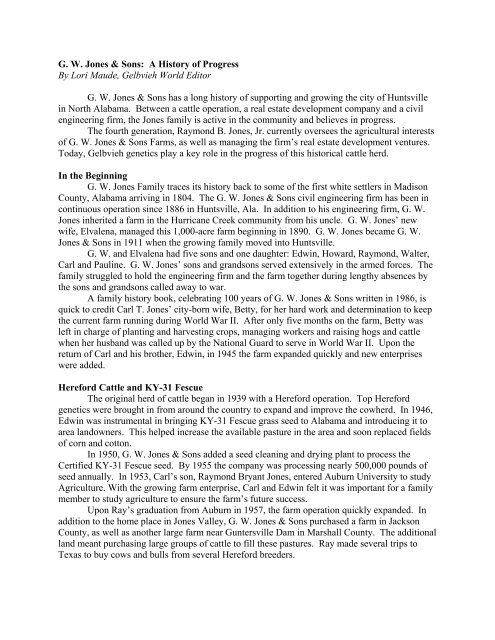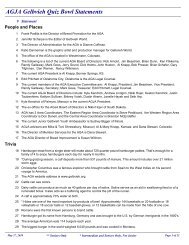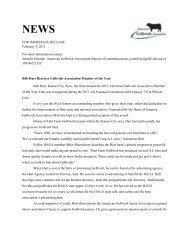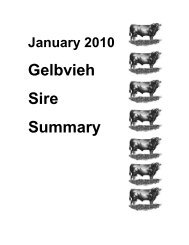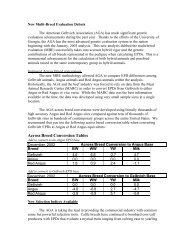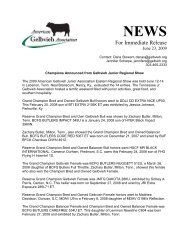G. W. Jones & Sons: A History of Progress By Lori Maude, Gelbvieh ...
G. W. Jones & Sons: A History of Progress By Lori Maude, Gelbvieh ...
G. W. Jones & Sons: A History of Progress By Lori Maude, Gelbvieh ...
You also want an ePaper? Increase the reach of your titles
YUMPU automatically turns print PDFs into web optimized ePapers that Google loves.
G. W. <strong>Jones</strong> & <strong>Sons</strong>: A <strong>History</strong> <strong>of</strong> <strong>Progress</strong><br />
<strong>By</strong> <strong>Lori</strong> <strong>Maude</strong>, <strong>Gelbvieh</strong> World Editor<br />
G. W. <strong>Jones</strong> & <strong>Sons</strong> has a long history <strong>of</strong> supporting and growing the city <strong>of</strong> Huntsville<br />
in North Alabama. Between a cattle operation, a real estate development company and a civil<br />
engineering firm, the <strong>Jones</strong> family is active in the community and believes in progress.<br />
The fourth generation, Raymond B. <strong>Jones</strong>, Jr. currently oversees the agricultural interests<br />
<strong>of</strong> G. W. <strong>Jones</strong> & <strong>Sons</strong> Farms, as well as managing the firm’s real estate development ventures.<br />
Today, <strong>Gelbvieh</strong> genetics play a key role in the progress <strong>of</strong> this historical cattle herd.<br />
In the Beginning<br />
G. W. <strong>Jones</strong> Family traces its history back to some <strong>of</strong> the first white settlers in Madison<br />
County, Alabama arriving in 1804. The G. W. <strong>Jones</strong> & <strong>Sons</strong> civil engineering firm has been in<br />
continuous operation since 1886 in Huntsville, Ala. In addition to his engineering firm, G. W.<br />
<strong>Jones</strong> inherited a farm in the Hurricane Creek community from his uncle. G. W. <strong>Jones</strong>’ new<br />
wife, Elvalena, managed this 1,000-acre farm beginning in 1890. G. W. <strong>Jones</strong> became G. W.<br />
<strong>Jones</strong> & <strong>Sons</strong> in 1911 when the growing family moved into Huntsville.<br />
G. W. and Elvalena had five sons and one daughter: Edwin, Howard, Raymond, Walter,<br />
Carl and Pauline. G. W. <strong>Jones</strong>’ sons and grandsons served extensively in the armed forces. The<br />
family struggled to hold the engineering firm and the farm together during lengthy absences by<br />
the sons and grandsons called away to war.<br />
A family history book, celebrating 100 years <strong>of</strong> G. W. <strong>Jones</strong> & <strong>Sons</strong> written in 1986, is<br />
quick to credit Carl T. <strong>Jones</strong>’ city-born wife, Betty, for her hard work and determination to keep<br />
the current farm running during World War II. After only five months on the farm, Betty was<br />
left in charge <strong>of</strong> planting and harvesting crops, managing workers and raising hogs and cattle<br />
when her husband was called up by the National Guard to serve in World War II. Upon the<br />
return <strong>of</strong> Carl and his brother, Edwin, in 1945 the farm expanded quickly and new enterprises<br />
were added.<br />
Hereford Cattle and KY-31 Fescue<br />
The original herd <strong>of</strong> cattle began in 1939 with a Hereford operation. Top Hereford<br />
genetics were brought in from around the country to expand and improve the cowherd. In 1946,<br />
Edwin was instrumental in bringing KY-31 Fescue grass seed to Alabama and introducing it to<br />
area landowners. This helped increase the available pasture in the area and soon replaced fields<br />
<strong>of</strong> corn and cotton.<br />
In 1950, G. W. <strong>Jones</strong> & <strong>Sons</strong> added a seed cleaning and drying plant to process the<br />
Certified KY-31 Fescue seed. <strong>By</strong> 1955 the company was processing nearly 500,000 pounds <strong>of</strong><br />
seed annually. In 1953, Carl’s son, Raymond Bryant <strong>Jones</strong>, entered Auburn University to study<br />
Agriculture. With the growing farm enterprise, Carl and Edwin felt it was important for a family<br />
member to study agriculture to ensure the farm’s future success.<br />
Upon Ray’s graduation from Auburn in 1957, the farm operation quickly expanded. In<br />
addition to the home place in <strong>Jones</strong> Valley, G. W. <strong>Jones</strong> & <strong>Sons</strong> purchased a farm in Jackson<br />
County, as well as another large farm near Guntersville Dam in Marshall County. The additional<br />
land meant purchasing large groups <strong>of</strong> cattle to fill these pastures. Ray made several trips to<br />
Texas to buy cows and bulls from several Hereford breeders.
The Next Phase<br />
Fast forward to the early 1980s and Ray begins to think the cowherd has a heat tolerance<br />
problem. To combat this, Ray purchased Santa Gertrudis bulls to breed to the predominantly<br />
Hereford cowherd. They would keep some <strong>of</strong> the best Hereford x Santa Gertrudis bulls to use on<br />
the Hereford cows to get a ¾ Hereford x ¼ Santa Gertrudis <strong>of</strong>fspring. Soon after this researchers<br />
discovered endophyte-infected fescue and its effect on cattle performance. Early research on<br />
infected versus non-infected fescue began in the mid to late 1970s and <strong>of</strong>fered an answer to the<br />
“over heating” <strong>of</strong> cattle grazing fescue.<br />
Ray made the decision to continue with the crossbreeding program even though it was<br />
likely not a heat tolerance issue. G. W. <strong>Jones</strong> & <strong>Sons</strong> started retaining ownership on its cattle to<br />
gain more information about their feedlot performance and carcass data.<br />
The Hereford x Santa Gertrudis cattle were only grading 30 percent Choice/Prime and<br />
simply weren’t performing well on the rail. Raymond Bryant <strong>Jones</strong>, Jr. joined the farm in 1993<br />
and began looking at other breeds to improve the quality grade.<br />
“It was obvious from the carcass data through the 1980s we weren’t making much, if any,<br />
improvement on quality grade,” says Raymond Jr. “We needed to do something different but we<br />
wanted to retain the red hide color in our cattle.”<br />
In the early 1990s Red Angus was incorporated into the herd through the bull battery.<br />
The quality grades improved to 65 to 70 percent Choice/Prime. “We made progress but I still<br />
thought we could do better and add more weight and performance to the calves,” shares<br />
Raymond Jr.<br />
Reading a Leachman Cattle Company catalog in 1994, Raymond Jr. got the idea to use<br />
Red Angus hybrid bulls. “Leachman really promoted the use <strong>of</strong> hybrid bulls and they were one<br />
<strong>of</strong> the few breeders I found that had a Red Angus x <strong>Gelbvieh</strong> hybrid,” explains Raymond Jr. “We<br />
bought our first <strong>Gelbvieh</strong> hybrid bulls from Leachman sight unseen.”<br />
The family hasn’t looked back since making the switch to Balancer bulls. Raymond Jr.<br />
continued to find more seedstock sources for red Balancer bulls, including Flying H Genetics<br />
from Nebraska. The carcass data proves the move was the right one. The last set <strong>of</strong> steers fed in<br />
2005 posted stats <strong>of</strong> 95 percent Choice/Prime with majority Yield Grade 2s and 3s.<br />
Managing for Today’s Market<br />
Raymond Jr. finds that a 50 percent <strong>Gelbvieh</strong> x 50 percent Red Angus Balancer bull<br />
works best on the cowherd. He is gradually moving the cowherd to a half <strong>Gelbvieh</strong> x half Red<br />
Angus breed makeup.<br />
Today the herd consists <strong>of</strong> about 700 head <strong>of</strong> brood cows, down from an all-time high <strong>of</strong><br />
1,200 head. The calving season runs in October and November with 85 percent <strong>of</strong> the calves<br />
born in the first 30 days. Birth date and birth weight are recorded for each calf born, as well as<br />
each calf is individually tagged for identification. “We haven’t moved to electronic<br />
identification (EID) yet but are keeping tabs on the National Identification guidelines,” admits<br />
Raymond Jr. “We would hate to put in a system and then find out that we don’t meet the final<br />
rules.”<br />
At weaning time, a weaning weight is taken on each calf before it leaves the farm.<br />
Raymond Jr. says steer calves are handled one <strong>of</strong> two ways, depending on the market. Some<br />
years they will wean the calves, retain ownership and place the steers on feed. They have fed<br />
cattle in Texas, Iowa, Colorado and Kansas.
More recently they have sold the steer calves directly <strong>of</strong>f the cow to the same order buyer<br />
the last six years. “We work hard with the buyer to follow the calves through the system to get<br />
the carcass data,” says Raymond Jr. “The carcass data can really show if our genetics are where<br />
they need to be.”<br />
The heifer calves are weaned the week after the steer calves. They sort the heifer calves<br />
into three groups. The top group is retained as replacements for the <strong>Jones</strong>’ cowherd. The bottom<br />
group is sold through the sale barn or if large enough to an order buyer via private treaty.<br />
The middle cut <strong>of</strong> heifer calves has developed a strong reputation as replacement females<br />
for commercial producers. The middle cut <strong>of</strong> heifers is weaned and developed on a lightgrowing<br />
ration. They are then sold via private treaty in small groups. “We have several repeat<br />
buyers for our heifers,” says Raymond Jr. “The cattle have developed a reputation for quality<br />
and productivity.”<br />
Since 1993, the computer has played a key role in managing the cowherd. All <strong>of</strong> the<br />
birth and weaning data is entered into each cow’s record. Prior to that records were kept by hand<br />
since the 1960s. “The computer gives each cow a MPPA score based on the birth and weaning<br />
information,” explains Raymond Jr. “It’s easy to see which cows are productive and which are<br />
not, so culling is not a guessing game.”<br />
With tight management and progressive genetics, the G. W. <strong>Jones</strong> & <strong>Sons</strong> cowherd is<br />
ready for the next generation. Raymond <strong>Jones</strong> III has already started his way up the ladder at<br />
eight years old. During the summer and other school breaks, Raymond III can be found doing<br />
chores at the farm to earn money for his college fund.<br />
“He knows he needs to start saving now if he wants to go to college one day,” says<br />
Raymond Jr. “My family has always believed in hard work and the farm teaches great lessons on<br />
responsibility and hard work. Raymond III is learning first hand and maybe one day he will have<br />
an interest in managing the farm.”<br />
Photo captions (located on the CD with the cover shot for November <strong>Jones</strong> & <strong>Sons</strong>):<br />
Raymond <strong>Jones</strong>, Jr., kneeling, is the fourth generation to manage G.W. <strong>Jones</strong> & <strong>Sons</strong> farm.<br />
Raymond III spends his summer breaks doing chores at the farm.<br />
Balancer bulls, with a few Red Angus bulls, make up the bull battery at G.W. <strong>Jones</strong> & <strong>Sons</strong>.


